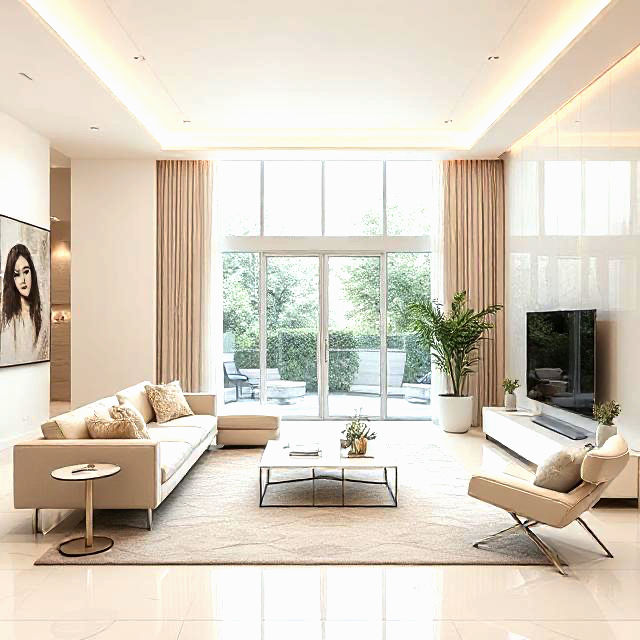Invisible Speakers: The Hidden Sound Revolution
- ARDENT-SPACE

- Sep 10
- 3 min read
Updated: Sep 18
In the world of architectural and luxury audio design, invisible speakers are making waves—without showing any. These systems hide entirely behind plaster, paint, wallpaper, wood panels, or even glass, creating an immersive sound experience without any visible hardware. Whether you’re designing a minimalist living room, a retail boutique, or a gallery, invisible speakers promise pure sound with zero visual clutter. But are they all upside? Let’s explore.
What Are Invisible Speakers?
Invisible speakers use flat-panel transducers or surface exciters that vibrate a thin layer of wall, ceiling, or other material to produce sound. Instead of projecting through a grille, the sound emanates from the surface itself. This makes them ideal for spaces where design purity matters just as much as audio performance.
Key Manufacturers & Their Approaches
Amina Sound – Edge & Mobius Lines
Amina is an industry pioneer in plaster-over and surface-integrated speakers. Their technology allows for multiple finish layers—paint, wallpaper, or veneer—while maintaining clarity.
Ceratec Audio Design (Cerasonar) – Architectural Audio Solutions
This German manufacturer offers customizable, high-end solutions, including invisible subwoofers for deep bass without the bulk.
Feonic (SoundBug) – Surface Exciter Technology
Feonic takes a different approach—small exciters that turn existing flat surfaces like glass or drywall into speakers.
JBL Conceal Series – Architectural Flush-Mount
JBL brings its pro-audio expertise into the architectural world with a series that mounts flush and disappears under surface treatments.
LB Lautsprecher (DE Plan Inside) – Furniture-Integrated Systems
Instead of walls, LB Lautsprecher often hides speakers inside furniture or wood paneling, ideal for bespoke interior design.
LiveWall – Direct-Radiating Invisible Speakers
LiveWall emphasizes high-fidelity, direct-radiating designs for purists who want performance without aesthetic compromise.
Monitor Audio – IV140 & Similar Models
Known for their home theater systems, Monitor Audio offers invisible options that integrate well with residential décor.
Revox – Flat Panel Systems
Revox integrates ultra-thin speakers directly behind walls, turning the surface into the soundboard while keeping the depth minimal.
Sonance – Invisible Series
Known for high-end residential and commercial installations, Sonance uses plaster-over panels that blend seamlessly into walls or ceilings. Their designs focus on wide dispersion and balanced tonality.
Stealth Acoustics – LR & B-Series
Offering both speakers and invisible subwoofers, Stealth Acoustics focuses on full-range sound systems that can rival visible high-end speakers in performance.
The Pros of Invisible Speakers
Aesthetics: No visible grilles, wires, or boxes—just clean lines.
Space-Saving: Perfect for rooms with limited space or where furniture placement is critical.
Customization: Can be installed in unconventional surfaces—ceilings, glass, wood panels.
Even Coverage: Many models are designed for broad sound dispersion, filling rooms more uniformly.
Design Freedom: Works with virtually any interior style without compromising acoustics.
The Cons of Invisible Speakers
Cost: Premium technology and installation often cost significantly more than traditional speakers.
Installation Complexity: Requires skilled installers; improper mounting can degrade sound quality.
Sound Quality Limitations: While improving, some models may not match the fidelity of visible high-end speakers, especially in bass response.
Inflexibility: Once installed and plastered over, relocation or adjustment is difficult.
Repair Challenges: Servicing often requires wall or ceiling repair.
Who Are They For?
Invisible speakers are best for:
Interior designers seeking seamless aesthetics.
Homeowners building custom homes with integrated audio.
Commercial spaces like galleries, boutiques, and hotels where visuals take priority.
Minimalists who want high-quality sound without visible hardware.
Manufacturer Comparison Chart:
Manufacturer | Country of Origin | Founded / Market Entry | Approx. Cost Level * | Performance Rating º | Installation Difficulty ‡ |
Amina Sound | UK | 1999, 2001 | $$$$ | ★★★★☆ | High |
Ceratec (Cerasonar) | Germany | 1999 | $$$$ | ★★★★☆ | High |
Feonic (SoundBug) | UK | 1999, 2004 | $$ | ★★☆☆☆ | Low |
JBL Conceal | USA | 1946, 2020 | $$$ | ★★★★☆ | Medium |
LB Lautsprecher | Germany | 1946, 1995 | $$$ | ★★★☆☆ | Medium |
LiveWall | USA | 2017 | $$$$ | ★★★★★ | High |
Monitor Audio | UK | 1972 | $$$ | ★★★★☆ | Medium |
Revox | Switzerland | 1948 | $$$ | ★★★★☆ | Medium |
Sonance | USA | 1983 | $$$$ | ★★★★☆ | High |
Stealth Acoustics | USA | 2003, 2008 | $$$$ | ★★★★★ | High |
* Cost Level: $ = budget, $$$$ = premium/luxury
º Performance on clarity, bass response, and dispersion based on market positioning and review exposure, which is why the US based firms score slightly higher here.
‡ Difficulty based on need for wall prep, finish work, and specialised expertise
Final Thoughts
Invisible speakers aren’t for everyone. They excel where design and space constraints matter most, but they require careful planning, a generous budget, and skilled installation. Choosing the right manufacturer—whether it’s Sonance for high-end plaster-over systems, Amina for design versatility, or Stealth Acoustics for a complete hidden setup—depends on your priorities. If you’re willing to trade a bit of traditional speaker performance for unmatched visual integration, invisible speakers might just be the perfect marriage of sound and style.





Comments